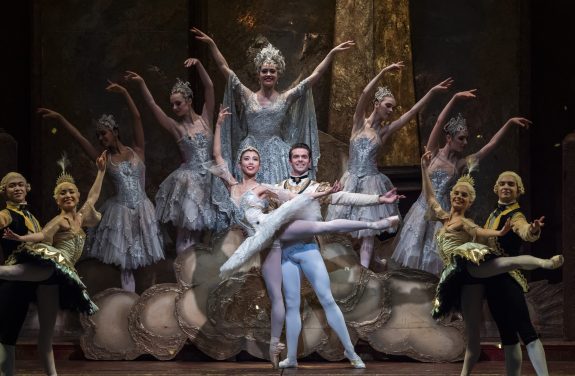 United Kingdom Tchaikovsky, The Sleeping Beauty: Dancers of Birmingham Royal Ballet, Royal Ballet Sinfonia / Philip Ellis (conductor), Sadler’s Wells, London, 24.4.2024. (JO’D)
United Kingdom Tchaikovsky, The Sleeping Beauty: Dancers of Birmingham Royal Ballet, Royal Ballet Sinfonia / Philip Ellis (conductor), Sadler’s Wells, London, 24.4.2024. (JO’D)

Creatives:
Choreography – Marius Petipa, Lev Ivanov, Sir Peter Wright
Music – Pyotr Ilyich Tchaikovsky
Production – Sir Peter Wright
Designs – Philip Prowse
Lighting – Mark Jonathan (adapted by Johnny Westall-Eyre)
Cast included:
King Florestan XXI – Jonathan Payn
His Queen – Yvette Knight
Princess Aurora – Yu Kurihara
Prince Florimund – Lachlan Monaghan
The Fairy Carabosse – Daria Stanciulescu
The Lilac Fairy – Eilis Small
Principals, First Soloists, Soloists, First Artists and Artists of Birmingham Royal Ballet
It was at Sadler’s Wells in 1939 that ‘the first real attempt’ was made, after Sergei Diaghilev’s The Sleeping Princess of 1921, to revive Marius Petipa’s original version of The Sleeping Beauty (1890). This week Birmingham Royal Ballet brought Sir Peter Wright’s 1984 production of the ballet back to Islington, where it was performed in an atmosphere of intimate grandeur.
Philip Prowse’s ‘post-modern’ designs (black and gold, marbled surfaces, an obelisk) dress the Lilac Fairy and the Fairy Carabosse as mirror images of each other: ‘good’ and ‘evil’, life and death. This reflects the corresponding themes that are present from the very beginning of Tchaikovsky’s ‘symphonic’ score, which is played with verve by the Royal Ballet Sinfonia under Philip Ellis. Costume choices for some of the other characters (fairies, princes) make them more difficult to distinguish from the dancers around them on the populated stage.
As Princess Aurora, First Soloist Yu Kurihara made the climax of the Rose Adagio on the opening night look as difficult to perform as I have ever seen it look. After that, though, her dancing sparkled, in both upper and lower limbs, like the diamonds on the headdress she wears in the Act II Vision Scene. Lachlan Monaghan was a powerful, thoughtful-looking Prince Florimund, capable of finding moments of stillness in the music and the dance.
Daria Stanciulescu, as the Fairy Carabosse, was never a caricature or pantomime figure. As Florimund pauses to reflect before kissing Aurora awake from her hundred-year-long sleep, the Lilac Fairy (Eilis Small) and Carabosse are equally vivid presences on the stage. The threat posed by the latter a serious one up to the very last moment.

The dances in celebration of Aurora’s wedding are performed with charm, playfulness and elan. Enrique Bejarano Vidal seems to float leisurely in the air as The Bluebird. Red Riding Hood and the Wolf (Rosanne Ely and Callum Findlay-White) serve as a reminder that fairy tales, even in a fairy tale, don’t always have happy endings.
The costumes for this act are updated from the mid-to-late seventeenth century of Act I to the mid-to-late eighteenth century in which Florimund is shown to live in Act II. This helps dispel the feeling you get at the end of other productions of the ballet, namely that Florimund (who has refused the love of a ‘real’ woman, the Countess) chooses to live surrounded by fairy tale characters one hundred years before his proper time.
Some of the other decisions made, to modernise the production perhaps, are more questionable. The display of toxic masculinity by two of the four princes who come to offer Aurora their hand in marriage. The way one of them follows Aurora around the stage after being rejected. But it is a very good idea to have the Lilac Fairy and Carabosse take their curtain call together. It reinforces the contrast between the ‘good’ and ‘evil’ that the ballet has fundamentally been about. It also forestalls the boos with which Carabosse can be greeted by a contemporary audience that makes no distinction between character and dancer.
John O’Dwyer
